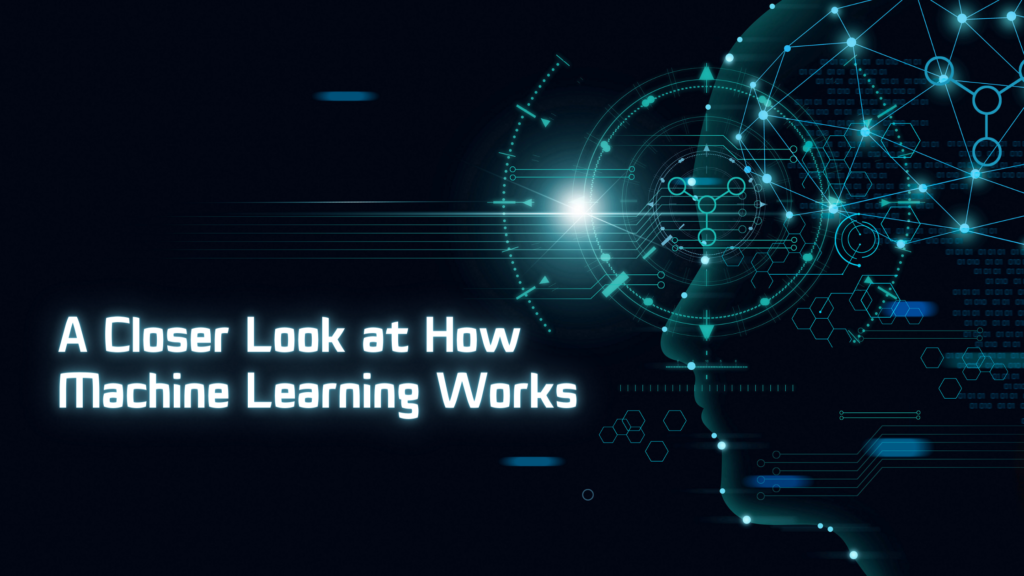How Does Machine Learning Work? Definitions & Examples

Machine learning, a subset of artificial intelligence (AI), has taken the tech world by storm. It enables computers to learn and make predictions or decisions without being explicitly programmed. But how does it really work? In this blog, we’ll demystify machine learning, explore its core concepts, and provide real-world examples to illustrate its functionality.
What is Machine Learning?
At its core, machine learning is about creating algorithms that can generalize patterns from data to make predictions or decisions. It encompasses various techniques, but its essence can be distilled into three fundamental steps:
- Data Collection: First, you gather relevant data. This data could be anything from customer preferences and historical sales data to images of handwritten digits.
- Training: You use this data to “train” a machine learning model. During training, the model learns patterns and relationships within the data, adapting its internal parameters to make accurate predictions.
- Inference: Once trained, the model can make predictions or decisions on new, unseen data. This is the essence of machine learning – the ability to generalize from known data to unknown data.
Types of Machine Learning
Machine learning can be categorized into three main types:
- Supervised Learning: In this type, the model is trained on a labeled dataset, where each data point has a corresponding target or outcome. The model learns to map input data to the correct output, making it useful for tasks like classification and regression.
- Unsupervised Learning: Here, the model is given unlabeled data and is tasked with finding patterns or structures within it. Clustering and dimensionality reduction are common tasks in unsupervised learning.
- Reinforcement Learning: In this type, the model learns through trial and error. It receives feedback in the form of rewards or penalties as it interacts with an environment. Reinforcement learning is used in applications like game-playing agents and autonomous robotics.
Examples of Machine Learning
Let’s dive into some real-world examples to better understand how machine learning works:
1. Email Spam Detection (Supervised Learning):
- Problem: Classify emails as spam or not spam.
- Data: A dataset of emails labeled as spam or not spam.
- Algorithm: Naive Bayes or Support Vector Machine (SVM).
- Outcome: The model can automatically filter out spam emails based on patterns it learned during training.
2. Recommendation Systems (Collaborative Filtering – Unsupervised Learning):
- Problem: Suggest products, movies, or music to users based on their preferences.
- Data: User behavior and preferences (e.g., purchase history, ratings).
- Algorithm: Matrix Factorization or Neural Collaborative Filtering.
- Outcome: Users receive personalized recommendations, increasing user engagement and sales.
3. Self-Driving Cars (Reinforcement Learning):
- Problem: Teach a car to navigate traffic and obey road rules.
- Data: Sensor data (e.g., cameras, LIDAR, radar) and feedback from the car’s actions.
- Algorithm: Deep Reinforcement Learning (e.g., Deep Q-Networks).
- Outcome: The car learns to drive autonomously by maximizing a reward function (e.g., staying on the road, obeying traffic lights).
The Power of Machine Learning
Machine learning has revolutionized industries from healthcare to finance, making predictions, automating tasks, and uncovering insights from vast datasets. It’s a dynamic field that continues to advance, with applications limited only by our imagination.
Understanding the fundamentals of machine learning is not only valuable for tech professionals but for anyone curious about the technology shaping our world. As you delve deeper into this exciting field, you’ll discover endless possibilities for creating intelligent systems that learn and adapt.
Conclusion
Machine learning is a transformative technology that has fundamentally altered the landscape of modern computing. It empowers computers to learn from data and make intelligent decisions, paving the way for a wide range of applications across industries. In this blog, we’ve unraveled the inner workings of machine learning, from data collection to model training and inference.
We explored the three main types of machine learning: supervised, unsupervised, and reinforcement learning, each with its unique set of use cases and algorithms. Real-world examples, such as email spam detection, recommendation systems, and self-driving cars, illustrate how machine learning is applied to solve complex problems and enhance our daily lives.
The power of machine learning lies in its ability to extract valuable insights from data, automate tasks, and make predictions that were once considered beyond the reach of computers. As machine learning continues to advance, it opens up new frontiers for innovation and discovery in fields as diverse as healthcare, finance, marketing, and autonomous systems.
For those interested in machine learning, the journey is both exciting and rewarding. By mastering the core concepts and techniques, individuals and organizations can harness the full potential of this technology to drive progress and shape the future. As we look ahead, machine learning promises to be a cornerstone of the digital revolution, ushering in a new era of intelligence and automation.

Leave a Reply